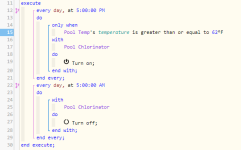- Aug 23, 2021
- 153
- Pool Size
- 17000
- Surface
- Vinyl
- Chlorine
- Salt Water Generator
- SWG Type
- CircuPool RJ-60 Plus
I'm fully aware of the lower water temps having an impact on production. My question is: does having the salt cell operating (and not producing much) at lower temps cause any unnecessary wear and tear / build up or is it only a matter of a lack of production?




